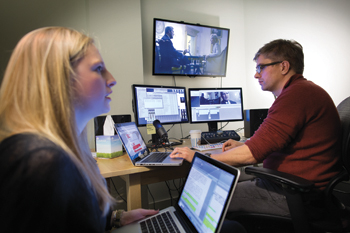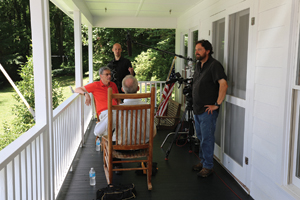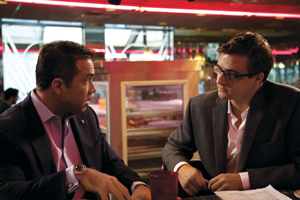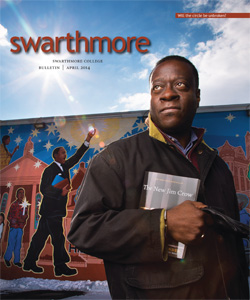April is the Coolest Month
‘60 Minutes’ veterans’ character-driven series on climate change makes its debut

Joel Bach (left) and David Gelber ’63 have such a copacetic partnership that Gelber refers to Bach as “my other wife.” Photo by Laurence Kesterson
It’s cold in New York City. Single digits. Trains aren’t running on time. Or at all. Amtrak even has to drag an old-timer out of mothballs to replace a newer engine seized up by the cold. But here, this January, in an office suite on 9th Avenue in Midtown, you’ll hear no jokes about global warming.
Instead, you’ll hear serious talk about the role climate change has played in the weather extremes of early 2014. You’ll also hear about ice fluctuations in the Antarctic, low-pressure air that is getting lower, increases in greenhouse-gas concentrations. The folks in this office are not climate scientists, however. They’re the editors and producers of Roaring Fork Films—working hard to bring the cold, painful facts to life for Years of Living Dangerously, a documentary series on climate change coming to viewers in April on Showtime.
David Gelber ’63, tall, lean, and dressed in black—from ribbed sweater to pants to boots—is peering intently at a gigantic computer monitor that displays 60 Minutes’ Lesley Stahl, her blue eyes wide in wonder, listening to ice crackling—like a giant bowl of Rice Krispies. She’s witnessing an icequake in Greenland.

Jess Harrop (left) works with Dan Madden on an edit of “Ice Wars,” a segment reported by Lesley Stahl featuring Secretary of State John Kerry. Photo by Laurence Kesterson
Gelber and two colleagues are editing a segment called “Ice Wars” for Years. To the left of the monitor is Jess Harrop, who brought her academic training in biology and theater to bear as the associate producer who accompanied Stahl to Greenland.
“Let’s go to 110003,” says Harrop, referring to the digital spot in this segment where climatologist Heidi Cullen is explaining to Stahl that science shows everything is interconnected and that what happens in the Arctic has consequences for the rest of the world.
Dan Madden, behind the console as editor, hits pause. He, Harrop, and Gelber debate how they can simplify the complex scientific concepts so viewers can quickly grasp the issues.
While making the science understandable to lay people, Gelber and company are “vetting this carefully [with experts] to be sure no one can say we are playing fast and loose with the science. I took one science class at Swarthmore—astronomy—and sat in the back and read Newsweek,” Gelber says, leaning back in his chair, confessing his own lack of scientific knowledge.
“Well, I was a film student. You’re one up on me,” counters Madden.
“This is our most science-heavy piece,” says Gelber, before moving on to the next scene with Stahl, showing her with Secretary of State John Kerry in his Washington office. Watching an exchange between Stahl and Kerry, Gelber pronounces, “That’s terrific. Let’s pull this. He’s very passionate here.”
And so it goes at Roaring Fork Films, the company that Gelber formed with Joel Bach in 2011. Stylistically, they contrast—Gelber, sleek, silver-haired; Bach, with rumpled flannel shirt and uncombed brown hair. But professionally, they gel, so much so that they’re often referred to as “Gelbach”—Gelber known for his attention to story and Bach for his visual sensibility. To start Roaring Fork, they gave up what Bach calls “the best job in TV, 60 Minutes.”

Above: David Gelber ‘63 (far left) produces an interview with former U.S. Rep. Bob Inglis, R-S.C. (in chair), at his farm near Greenville, S.C.
At the venerable news show, producers don’t have beats, and Bach, who kept pitching story ideas on climate change, not always successfully, wanted to tackle the issue in a substantive way. Gelber, who cut his activist teeth at Swarthmore participating in civil-rights activities in nearby Chester, Pa., and Cambridge, Md., wanted to tackle a major global issue and help make a difference.
“I think climate change now is where civil rights was in 1957,” says Gelber, chair of the Swarthmore Board of Managers’ Social Responsibility Committee. “Other than nuclear war, I can’t think of anything out there that’s more potentially disastrous than human interference with the climate. And yet, we had three presidential debates in summer 2012 and not one question was asked about climate change. That’s astonishing,” Gelber says. “We’re trying to make sure that doesn’t happen again.”
Something else that draws him to the climate issue is “the fact I have young kids,” says Gelber. He’d like to preserve the world his daughters inherit.
Roaring Fork—named for a river near where Bach grew up in Colorado and where Ed Bradley, the late 60 Minutes correspondent for whom Gelber long served as producer, had a home—was formed to support the Years project.
Although there have been other grand climate-change productions, including Al Gore’s An Inconvenient Truth and The 11th Hour, which was produced and narrated by Leonardo DiCaprio, Years is different.
The celebrity factor is one delineator. Whereas DiCaprio was presented as a climate expert in the substantive but yawn-producing 11th Hour, celebrities in Years stand in as everyman. They may not be experts, but these folks—Matt Damon, Harrison Ford, Jessica Alba, Don Cheadle, Arnold Schwarzenegger, among them—care. And they’re appealing to the common viewer who might not care about the issue.
“We want to entertain people who think they are seeing a Matt Damon movie,” says Bach. “It’s shot in an interesting way, so maybe you will stick around and watch it.”

Gelber produces a segment that features Patricia Dresch, whose daughter and husband died in Superstorm Sandy.
Years also benefits from the storytelling approach Gelber learned from 60 Minutes’ founder and executive producer Don Hewitt, “an amazingly talented journalist who insisted we do stories driven by great characters” and who wanted the narrative to unfold “so you don’t know how it will end,” Gelber says.
Besides the likes of America Ferrera and Michael C. Hall, Years’ correspondents include solid journalists such as Stahl, The New York Times’ Thomas Friedman and Mark Bittman as well as Chris Hayes of The Nation and MSNBC’s All In with Chris Hayes.
Instead of showing the correspondents in offices or hotel rooms interviewing their subjects, à la 60 Minutes, the Years correspondents go on site.
Hayes spent a year reporting two Superstorm Sandy–related segments for the series. In one Gelber-produced segment, set on Staten Island, he interviews Patricia Dresch, just six weeks after her daughter, Angela, and husband, George, perished when the storm washed away their Tottenville home.
“It was the hardest interview I’ve done on television and perhaps the hardest interview I’ve done in journalism,” says Hayes. “She’d just gone through about the worst thing a person could go through. It was really …” he says somberly, his voice trailing off.
“They’ve done something that really hasn’t been done before,” says Hayes of the Years project. “The visual grammar of the series is the visual grammar of film, more than it is the visual grammar of 60 Minutes. It looks like a movie.”
Hayes mentions a scene in the Tottenville segment that shows firefighters sitting around a table describing the moment they found Pat Dresch suffering from severe hypothermia. “It’s this dramatic chiaroscuro lighting on them, and the camera moves around the table like a shot from Reservoir Dogs. It’s brutally effective.
“It’s incredible what you can do when you have the time, the resources, and the unbelievable experience and talent that David and Joel and Solly [Granatstein, a co-executive producer], and everyone else have brought to this,” Hayes adds.

Chris Hayes (right) interviews U.S. Rep. Michael Grimm, R-N.Y. Grimm changed his mind about climate change during the year Hayes spent reporting this segment of Years.
While Hayes contends that climate change is the most important story of today, he also asserts that it’s the hardest story to tell. “It’s not a particularly visual story. Carbon is invisible, and that’s a huge problem. It seems abstract and remote to people. So you need to do a lot of on-the-ground reporting and take the time to tell stories that are situated within the context of the front lines of this battle, this crisis, that we’re experiencing. That’s what’s so exceptional about this project. It’s as exciting a project as I’ve ever been a part of, and it’s amazing that they pulled this off.”
To do so, Gelber found himself “using muscles I’ve never used before.” Among the unfamiliar tasks were raising millions of dollars and casting the correspondents, which meant dealing with agents, lawyers, and contracts. (The celebrities were paid much less than their customary fees.)
While Roaring Fork raised some money from Showtime, most of the early seed money came from Jeremy Grantham, an investment strategist who is a manager of Swarthmore’s endowment. Gelber also used a contact from the prep school he attended. The headmaster there connected him with fellow Pingry School alum Amos Hostetter, founder and former CEO of Continental Cablevision.
“This would never have happened without Amos,” Gelber says. “He’s a great philanthropist and an iconic figure in the world of television. He cares deeply about this issue and was able to open a lot of doors for us, including at Showtime. That’s aside from the fact that he helped fund us and pestered his friends to do the same.”
Through a Bach connection, the duo brought on film producer Jerry Weintraub as a co-executive producer. Then “James Cameron heard about us and invited me to lunch in Malibu,” says Gelber. The director of Titanic and Avatar said he would support Years “as long as we had a social media plan to amplify and extend the message of the TV series,” he adds. “I told him that’s exactly what we want to do. He agreed on the spot to be an executive producer.”

David Gelber in his New York office.
With Cameron’s help, Gelber and Bach connected with Paul Allen, co-founder of Microsoft, who directed Vulcan, his philanthropic organization, to allocate $1.8 million to an outreach and engagement campaign. Microsoft also is sponsoring the series and will feature it and its website on its platforms, including MSN, Bing, Skype, and X-Box.
The Years team has partnered with major environmental organizations, such as the National Resources Defense Council and the Sierra Club, “to extend the reach of the series,” says Gelber. For instance, the Sierra Club, which has a campaign to close down coal plants, will connect its efforts with a segment on coal-fired power plants featuring Vampire Diaries star Ian Somerhalder.
Curricula that build on Years’ themes and footage are being developed in partnership with the National Wildlife Foundation and will be introduced in several hundred schools for students in grades four to 12, according to Bach. The Years project also has received funding that will measure the series’ impact on public awareness of climate change.
Gelber hopes the impact is wide and extends beyond the series’ first eight episodes, which air at 10 p.m. EST on Sundays, beginning April 13. The first two episodes will be shown free on Showtime. The leadoff segment, says Gelber, features “Harrison Ford’s story on deforestation in Indonesia, Don Cheadle’s story about drought in Texas, and Tom Friedman’s story about climate change (drought, specifically), and the civil war in Syria.”
He and Bach are trying to reach skeptical viewers—not only climate-change true believers—and they expect that will take more than a year. They’re hoping Years sees a year two and three. Although they realize the series probably won’t change the minds of hardline deniers, they hope to make progress with others, even those who already understand “what we’re doing to the climate,” says Gelber. “Our goal is to move people who are a five on the engagement scale to an eight. That’s a huge gain.”
To learn more or to get involved, go to yearsoflivingdangerously.com.
 Email This Page
Email This Page